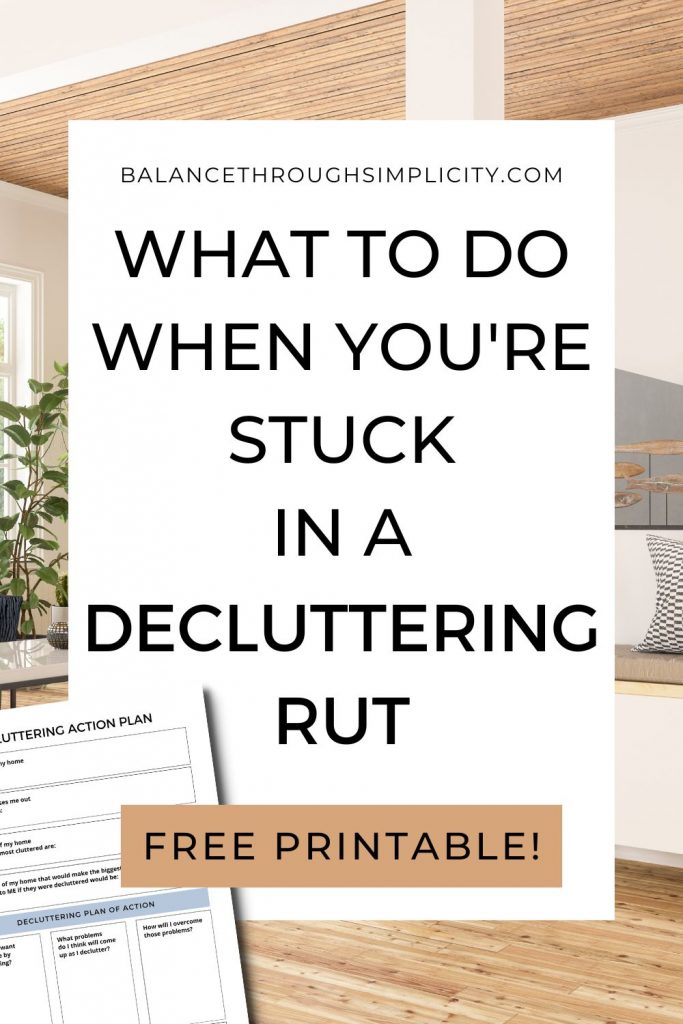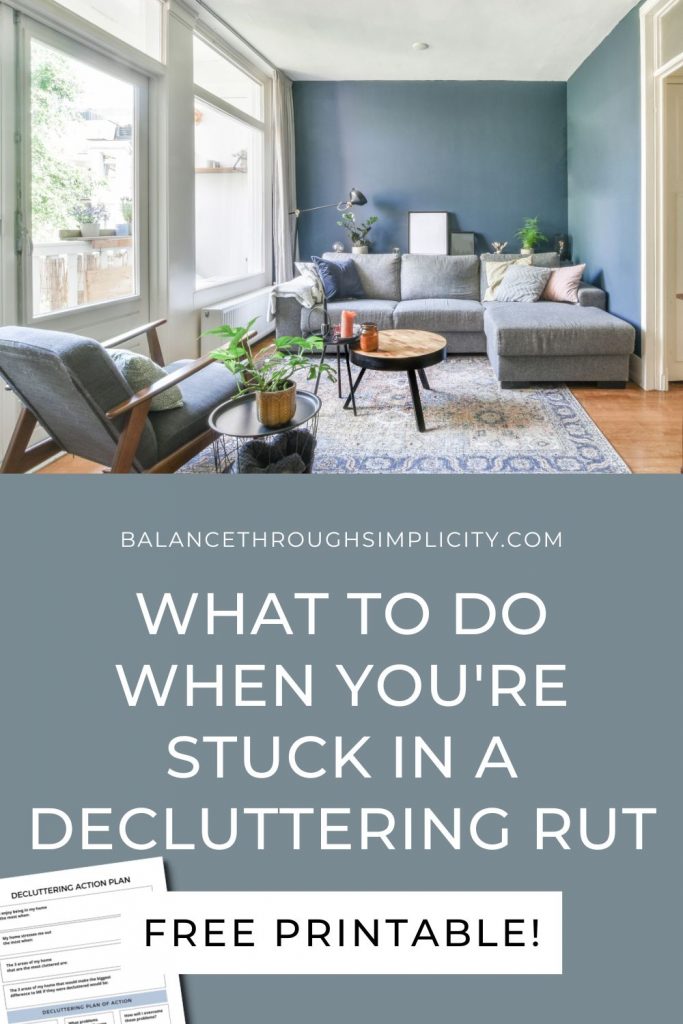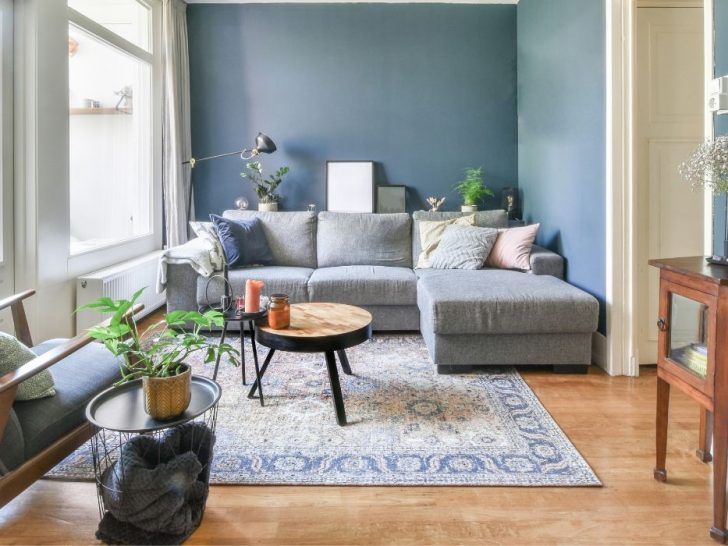WHAT TO DO WHEN YOU’RE STUCK IN A DECLUTTERING RUT
Stuck in a decluttering rut? Here are some tips on what to do if decluttering feels tough and overwhelming. Simple ideas to help make decluttering easier and more effective.
WHAT IS A DECLUTTERING RUT?
Decluttering can be physically and emotionally draining. Decluttering also requires motivation, patience, time, perseverance and it helps to have friends and family to support you.
Sometimes we feel guilty for getting rid of stuff that cost us money, or was given to us as a gift by loved ones, or that was passed down through previous generations.
Decluttering and simplifying life isn’t easy and it’s not unusual to feel overwhelmed and stuck.
Getting stuck in a decluttering rut can happen because of all these things and the end result is that the clutter builds up, it’s a constant battle against the daily influx and we lose energy, confidence and oomph.
If any of these scenarios sound familiar to you, I hope this article helps!
WHAT TO DO WHEN YOU’RE STUCK IN A DECLUTTERING RUT
Here are some tips on what to do when you’re stuck in a decluttering rut.
1. Take a break
If you’re stuck in a decluttering rut and feel like you can’t get out of it, don’t give up! Take a break for now, for today. Instead, make a plan to decide what you’re going to declutter and when and how you’re going to do it.
In fact, I have a free printable you can get with this post to help you create a Decluttering Action Plan. Pop your details in the box at the bottom of this article to receive your copy!
Taking a break doesn’t mean you’ve giving up. It just means you recognise that now is not the time to be making potentially difficult decisions about the stuff in your home and life. Better to wait until you’re in the right decluttering mindset and have a clear plan for what you want to achieve.
Take a break but don’t give up. Use the tips in this article to help you build motivation, confidence and clarity for your decluttering.
2. Be clear on your why
As with anything in life, in order to achieve something it helps to know why you’re doing it. Decluttering is no exception. Ask yourself why you want to declutter your home and life.
- What do you want to achieve and why?
- What do you want to change about your home or your life?
- How will decluttering help you do that?
- How will you feel after you’ve decluttered?
Decluttering our homes means we have less stuff to move, tidy and clear. Less clutter means it’s quicker to keep our home tidy and we can spend less time cleaning and managing our home. That means we can have more time for family, friends, hobbies, relationships, self-care, learning and laughter.
Our home becomes a sanctuary from the busy, outside world and can be a calm place in which to relax and recharge. A minimalist family home isn’t dull, empty or boring but it’s a relaxing haven where we can return to at the end of a busy day.
The last thing you want is for your home to feel a stressful burden and drain your energy.
Further reading: How to declutter your home and life
3. Be clear on your decluttering goals
Just like it helps to know why we’re doing something, it also helps to set goals in life. Goals can be flexible and changeable and you can revisit and refresh them whenever you feel stuck in a decluttering rut (or a rut more generally!), but they give you a framework to track your progress and stay focused and motivated.
Decluttering goals could be things like decluttering a certain area or type of item, giving yourself a particular timescale, simplifying your wardrobe to make your mornings easier, getting rid of items if you’re decluttering before moving and need to downsize.
Decluttering goals should be simple, easy to achieve (or at least to break down into actionable steps) and easy to measure. You want to be able to see clearly when you’ve achieved your goal otherwise you won’t be able to tick it off and know you’ve done it!
Further reading: Decluttering goals and why they’re important

4. Ask the right decluttering questions
Sometimes we get stuck in a decluttering rut because we’re not sure what to declutter. We start to keep things ‘just in case’ or because they have sentimental and emotional attachment or we feel wasteful.
All perfectly common reasons to keep stuff and hoard clutter but they don’t help us feel comfortable and confident in making decluttering decisions about whether to keep stuff or get rid of it.
If you feel you’re in a decluttering rut, try asking yourself some questions every time you go to declutter an item. Instead of holding on to things out of habit, fear or uncertainty, use your decluttering questions to help you look at each item objectively and from a fresh perspective.
When did you last use that item? Could you borrow or loan it again if you needed it? Does it make you feel good? Would you buy it now? Does it have an expiry date? Do you have duplicates? Do you have something similar? Can you make do without it?
Re-framing your thoughts around your stuff can help you look at what you own from a different point of view and help you declutter more effectively.
Further reading: Decluttering questions to help you declutter more effectively
5. Have fun
Decluttering doesn’t have to be stressful, time-consuming or overwhelming. Decluttering can (and often should) be liberating, empowering and exciting. Just imagine what your clutter-free home and life can give you time, space and freedom to do instead!
If you’re stuck in a decluttering rut, try making it fun. Get family and friends to help, put some background music playing, a cup of tea, coffee or your favourite drink within reach. Plan a reward or incentive for yourselves afterwards.
Get all your decluttering supplies ready so you won’t get stuck mid-way because you run out of boxes or bags to put things in.
Keep decluttering fun and light-hearted, even if you’re decluttering on your own. This is your chance to take control over your stuff and make your home and your space feel under control and calm.
Further reading: How to make decluttering fun
6. Declutter somewhere easy
If you’re finding decluttering tough, I’d suggest you declutter somewhere easy to help you build decluttering confidence.
Decluttering the bathroom is a good place to start, or revisit because it’s often a relatively small space, storage and countertops are limited and you tend to know what you use and what you don’t.
Leave those difficult to declutter areas like the loft, garage, sentimental items and arts and crafts supplies until you’re feeling more relaxed and confident about the decluttering process.
Start decluttering somewhere easy so you can both see and feel the effects of your hard work. With the bathroom, notice how much easier it is to keep the room clear, clean and tidy and, often, how much bigger the space feels when there’s less clutter and stuff in it!
Further reading: How to declutter your bathroom (and free Bathroom Declutter Checklist!)

7. Declutter little and often
When decluttering feels tough, break it down into manageable chunks. When we overestimate our time and energy and underestimate how much stuff we actually have to declutter then no wonder we find ourselves in a decluttering rut that it’s hard to climb out of.
Decluttering feels ovewhelming and stressful when we expect too much of the resources we have available. The same goes for any big and/or difficult project in life.
Break decluttering down into small windows of time, or areas of your home. Declutter little and often if that feels easier and less stressful than having to devote an entire weekend to decluttering.
Little and often feels easier, for both our bodies and brains, and you can approach each decluttering session with a fresh mindset, boost of energy and clear idea of what you want to achieve by the end of it.
Here are some tips for decluttering if you don’t have time to declutter, how to declutter fast and some quick ways to simplify your space.
8. Watch out for hidden clutter
Sometimes we get stuck in a decluttering rut because we can’t see progress and we feel frustrated. There are several ways to track progress which we look at it in this article, including setting decluttering goals, having a checklist or participating in a decluttering challenge.
However, clutter is sneaky and there are many different types of clutter that invade our home, schedule, heart and mind in different ways.
This hidden clutter can take many forms. It could be mental clutter clouding your mind, it could digital clutter clogging up your inbox, it could be expired food sitting in your pantry. Hidden clutter is also stuff in the drawers that’s out of sight and out of mind. Clutter hidden under your bed, on top of your wardrobe, or sitting in the guest room that’s never used.
Clutter isn’t always as hidden as these examples. There are many other ways that your home can still look cluttered even though you think you’ve already decluttered.
Some examples of things that make your home look cluttered could be too many pictures on your walls, mis-matched patterns, too many cushions, appliances left out on the kitchen counter or lack of storage so stuff never gets put away.
Ideally you want to see progress with your decluttering so you’re motivated to carry on but sometimes we have clutter that we don’t see. We become clutter-blind to the stuff that sits in our home because we see it each and every day.
Further reading: 32 Things that make your home look cluttered
9. Build good decluttering habits
Clutter tries to creep back into our homes daily so decluttering is not a once-and-you’re-done kind of project. It’s a good idea to build good decluttering habits so you don’t get demoralised and frustrated by the cycle of clutter and a build up of stuff even after you’ve just decluttered.
Clutter attracts clutter so tackling table-tops, kitchen counters, the bathroom and keeping up with laundry and other household routines will help keep your home clutter-free moving forwards.
Further reading: 20 habits for a clutter-free home
10. Create incentive and celebrate your wins
Just like making decluttering fun, creating an incentive around decluttering also helps combat getting stuck in a rut.
- Declutter a room and then allow yourself to redecorate or switch the furniture around.
- Get take-away pizza after a decluttering session instead of having to cook.
- Save up some money to invest in a good quality jacket after purging your closet and identifying your personal uniform.
You know yourself best so work out what kind of incentive will motivate you to declutter so you have something to really look forward to!

11. Get help and support
You may prefer to declutter on your own but it can also be very helpful and fun to get support from family and friends.
If they’re happy to declutter with you and share the same goals and expectations as you, get them on board!
On the flip side, if your family and friends aren’t ready to declutter and you meet resistance, go slow with them, provide gentle encouragement but don’t declutter their stuff until they’re ready or they ask you to.
Further reading: How to declutter when your spouse doesn’t want to
12. Take a challenge
You might be happy going room to room with a bin bag or box. Yet, for many of us, decluttering is easier and more fun when you make it into a challenge.
- See how long it takes you to declutter 20 items.
- Who can gather up the most items in 5 minutes?
- Take Courtney Carver’s minimalist fashion challenge, Project 333.
Try these free challenges to help motivate and focus you (they come with free printables you can download too!):
LEAVE A COMMENT
I’d love to know if you’ve ever got stuck in a decluttering rut. Were you trying to declutter something particularly difficult or did you just feel overwhelmed and unmotivated about the whole process? How did you overcome it and how do you feel if you have less clutter now? I’d love to hear your thoughts so please leave a comment below!

